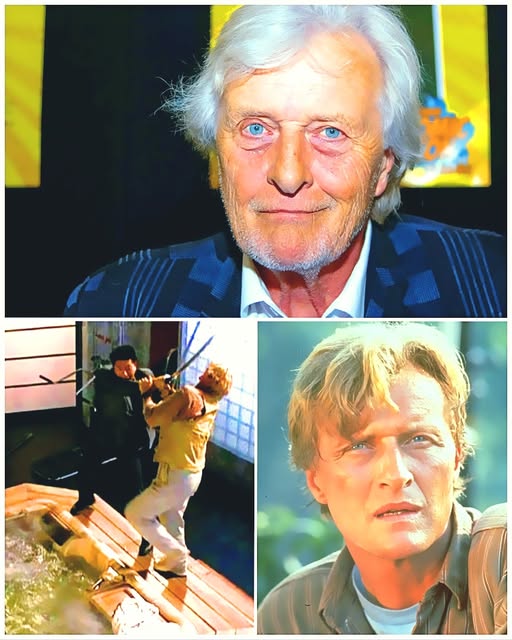
The fight scene had been rehearsed a dozen times already. The set of “Blind Fury” (1989) was buzzing with energy, crew members moving quickly between takes, resetting props and angles for the next sequence. Rutger Hauer stood in position, sword in hand, awaiting the cue for a high-intensity stunt involving a moving vehicle and a carefully timed fall. No one expected anything to go wrong until it did.
Rutger Hauer, known for his intensity and precision, was filming a scene where his character, the blind swordsman Nick Parker, battles attackers while navigating obstacles. A stuntman was to perform a controlled fall near a rapidly moving car, stopping inches short of impact. But as the car approached and the cameras rolled, something in the timing faltered. The fall was late, and in that split second, disaster was imminent.
Without hesitation, Hauer broke character mid-action and lunged forward, pulling the stuntman by the collar and out of the car’s path. The crew froze, the director yelled “Cut!”, and for a few moments, the set went completely silent. What could’ve ended in a critical injury was narrowly avoided because of Hauer’s instincts.
Stunt coordinator John C. Meier later recalled, “It was one of those moments where your heart sinks, and then you realize what just happened. Rutger moved faster than anyone else could’ve reacted. He saw it before the rest of us did.” He wasn’t supposed to deviate from the choreography, but his awareness transcended the script.
The stuntman, a seasoned professional who had worked on multiple action films in the 1980s, admitted that the mishap was partially his fault. “The car came in half a second too early, and I slipped slightly as I pushed off,” he said in an interview years later. “Rutger saved me. No question about it. I could feel the wind from that bumper.”
What made Hauer’s reaction extraordinary wasn’t just the physical speed, but the calm decisiveness in a chaotic moment. Those present noticed he didn’t flinch or panic. One crew member described it as “watching someone who was in complete command, like he wasn’t acting anymore, he just was that guy.”
“Blind Fury” was already a demanding shoot. A remake of the Japanese film “Zatoichi Challenged,” it blended martial arts, dark humor, and emotional depth, all balanced on Hauer’s shoulders. He had immersed himself in the role of a blind Vietnam veteran turned wandering swordsman, learning movement patterns of visually impaired individuals and studying swordplay with martial arts trainers. He spent long hours with real-life blind consultants to get the smallest details right. By the time filming reached its mid-point, he wasn’t merely performing a character, he was living inside one.
The incident changed the atmosphere on set. Hauer, already admired for his talent, earned a new layer of respect. The stunt team, many of whom had worked with major stars, spoke in quiet admiration behind the scenes. As one veteran stuntman put it, “You don’t expect the lead actor to be the one who saves your skin. They usually stay out of it. Rutger didn’t even hesitate.”
What followed wasn’t some grand celebration. Hauer brushed off the praise, humbly nodding to the stunt team and returning to the set for the next take. But word spread fast. Even those not present during the incident talked about it days later. Director Phillip Noyce mentioned in an interview that Hauer’s attitude on set, always focused, never ego-driven, was part of what made “Blind Fury” (1989) work as both an action movie and a character study.
In a genre often built on illusion, Rutger Hauer delivered something very real. His instincts weren’t part of the choreography, but they saved a man’s life and earned him a permanent place in the respect of those who risk theirs for cinematic thrills.
On that day, Hauer proved that heroes don’t always live in the script; they sometimes live in the space between seconds.
